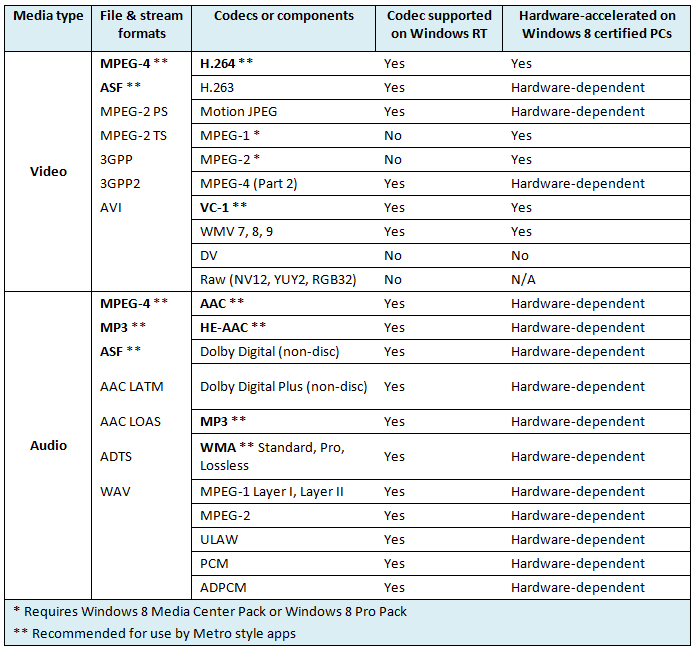Optimize audio and video processing in Windows 8
Microsoft experts talked about significant optimization of software decoders in Windows 8, due to which the processor load, memory consumption, etc., decreased.
Using CPU when decoding 720p VC1 / H.264 video and previewing from a webcam

Video decoding performance has increased due to optimization of software decoders for H.264 and VC-1, and the improvement in video processing from a webcam is due to the transition from the DirectShow Capture API to a new, much more efficient Windows 8 Media Foundation Capture API.
The developers also significantly changed the algorithm for processing audio content before playback, so that they were able to significantly reduce the load on the CPU and battery consumption on mobile devices. This is done due to increased buffering - splitting audio recordings into larger fragments that are processed in advance by the processor, and then it goes into sleep mode. As a result, now the duration of the sleep intervals of the CPU has increased by 100 times - from 10 milliseconds to more than 1 second, which drastically reduces the power consumption of the audio player.
')
Another important optimization was the introduction of low-latency low-latency media capture and rendering to the OS. This is done to ensure perfect chat performance in Skype, including video chat in HD mode.

According to the TIA / EIA 920 standard, sound should be transmitted with a delay of no more than 100 milliseconds, and video should be no more than 145 milliseconds. Microsoft developers have been able to achieve both of their goals, even for high-resolution video.
Sound Delay: 65m

Video transmission delay: 100 ms

Recommended video codecs for use in Windows 8 applications are H.264 and VC-1.

Using CPU when decoding 720p VC1 / H.264 video and previewing from a webcam

Video decoding performance has increased due to optimization of software decoders for H.264 and VC-1, and the improvement in video processing from a webcam is due to the transition from the DirectShow Capture API to a new, much more efficient Windows 8 Media Foundation Capture API.
The developers also significantly changed the algorithm for processing audio content before playback, so that they were able to significantly reduce the load on the CPU and battery consumption on mobile devices. This is done due to increased buffering - splitting audio recordings into larger fragments that are processed in advance by the processor, and then it goes into sleep mode. As a result, now the duration of the sleep intervals of the CPU has increased by 100 times - from 10 milliseconds to more than 1 second, which drastically reduces the power consumption of the audio player.
')
Another important optimization was the introduction of low-latency low-latency media capture and rendering to the OS. This is done to ensure perfect chat performance in Skype, including video chat in HD mode.

According to the TIA / EIA 920 standard, sound should be transmitted with a delay of no more than 100 milliseconds, and video should be no more than 145 milliseconds. Microsoft developers have been able to achieve both of their goals, even for high-resolution video.
Sound Delay: 65m

Video transmission delay: 100 ms

Recommended video codecs for use in Windows 8 applications are H.264 and VC-1.

Source: https://habr.com/ru/post/145600/
All Articles